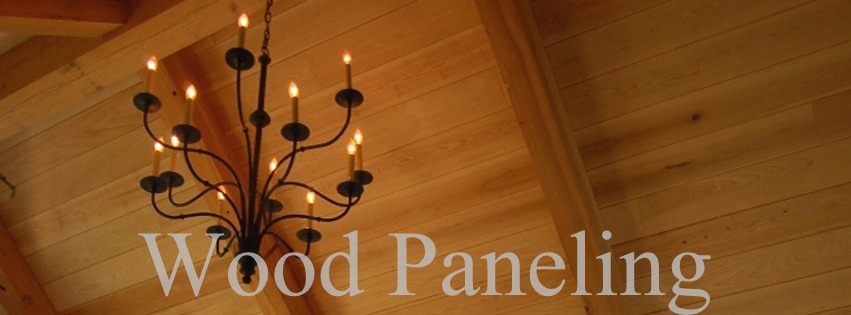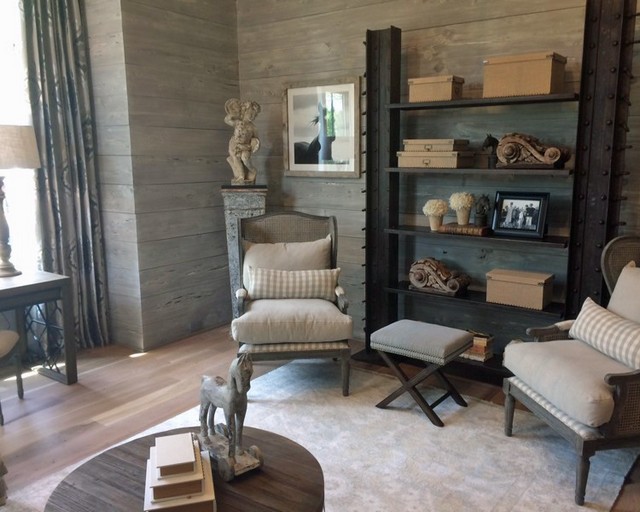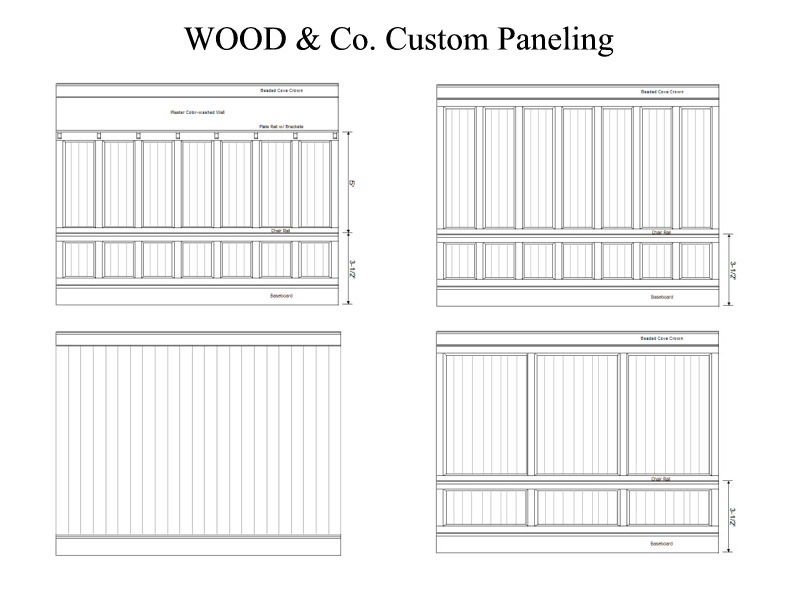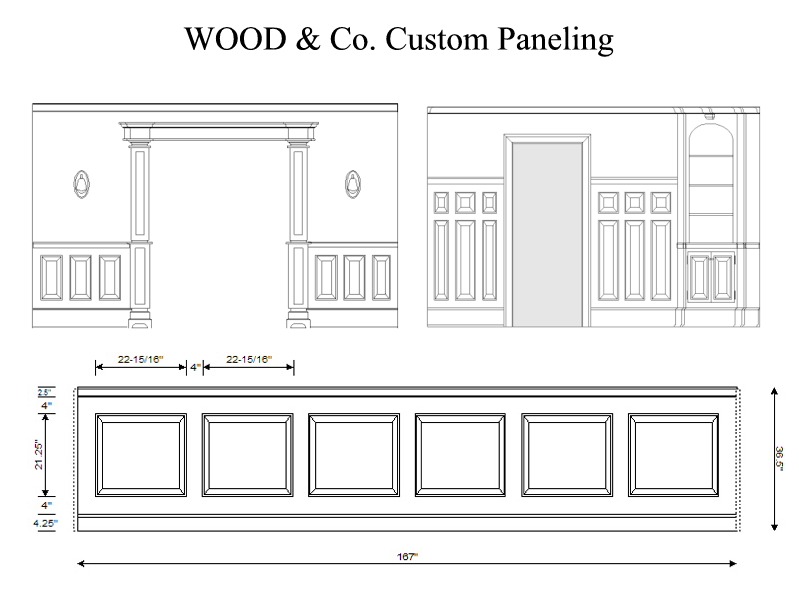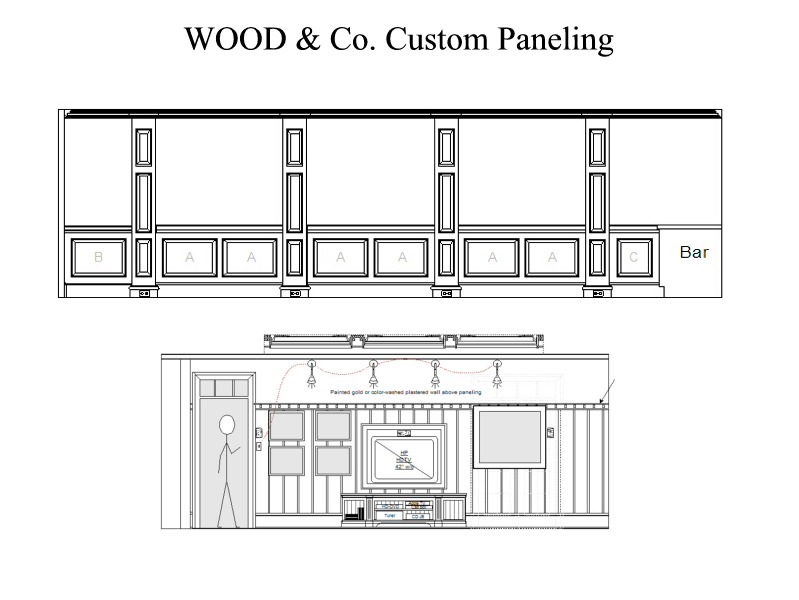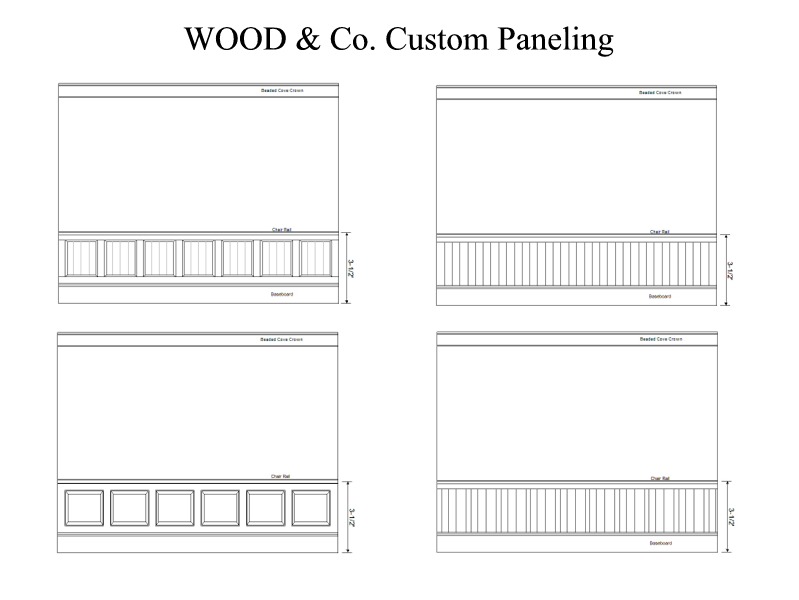Consider what your home would look like with hardwood paneled walls. Imagine floating raised panels, traditional Pickwick, v-grooved, or beaded vertical panels. Envision your stunning hardwood wall paneling all tied together with impressive baseboards, casings, and crown moldings. From pecky cypress to cherry to mahogany wood paneling, woodwork brings character to virtually any space and adds value to your home. Our interior wall paneling will improve the warmth of your home and create a rustic appeal not available with other materials.
At WOOD & Co. in Atlanta, GA, we go above and beyond creating and installing gorgeous hardwood wall panels. We also provide dramatic paneling for ceilings. Think of the crisp, striking beauty of dark, rich mahogany wood paneling framed in white crown wood moldings. Just like with paneled wall systems, there are an endless variety of looks that you can bring to your space. We specialize in creating complete wooden rooms in nearly any wood species you want. Contact us today and find out how we can help you get the best interior wood paneling for every surface in your home. We look forward to helping you establish a more peaceful atmosphere with a connection to nature found in few homes.
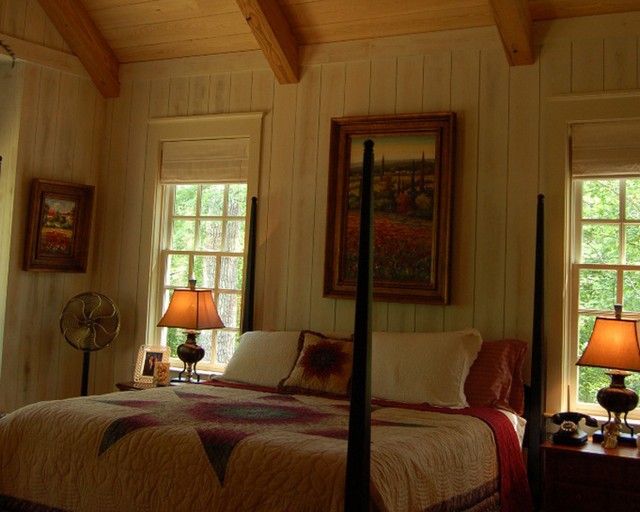
Bald cypress v-grooved T&G ceiling, with color-washed shiplap poplar walls.
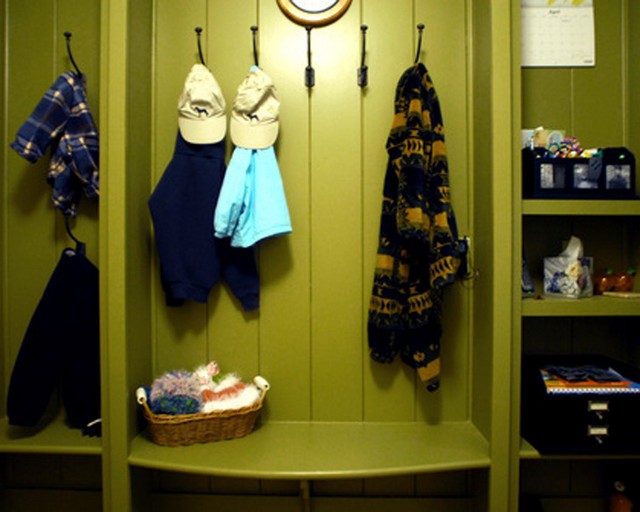
Painted v-grooved poplar paneling.
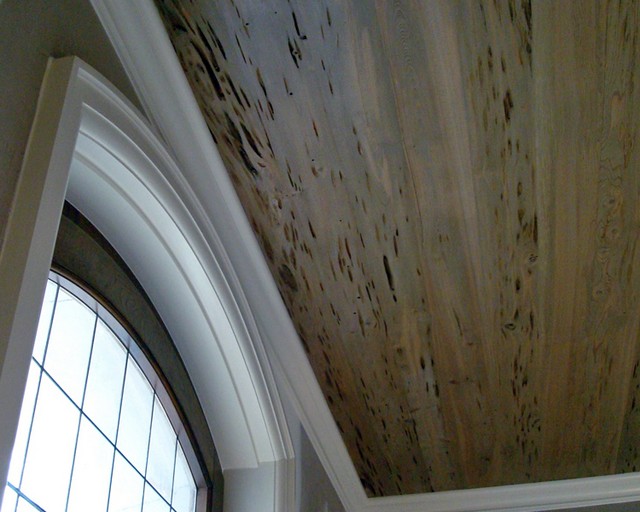
Stained Pecky Cypress shiplap ceiling paneling. Please to have our Pecky Cypress selected for the new Suntrust Park Atlanta Braves Baseball Stadium.
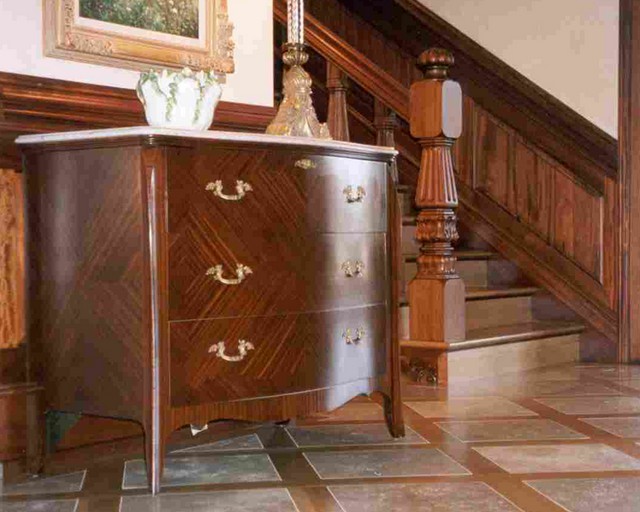
Mahogany raised-panel wainscot paneling set in mahogany rails & stiles.
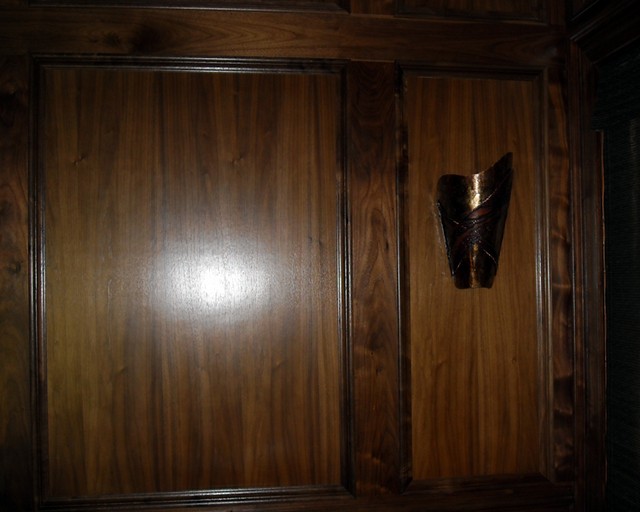
American Black Walnut flat-panel paneling with walnut rails & stiles, and molding.
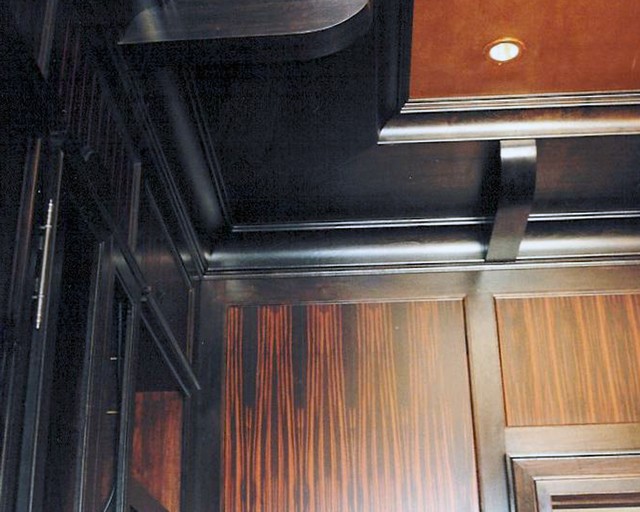
Macassar ebony paneling set into black walnut rails & stiles. Walnut beams and cabinetry, gilded ceiling
PANELING IDEAS
PANELING SPECIFICS
WOOD & Co. wall and ceiling wood paneling is available in a wide range of wood species. Our paneling is solid 3/4″ thick, end-matched, and kiln dried.
Standard widths available from 3″ to 8″, with wider available in some species and cuts. We commonly provide fixed and random widths, with our most popular being 3,4,5″, 3,5,7″, and 4,6,8″ patterned width.
Standard grades include select, character, and rustic. Antique heart pine and oak flooring are available in fresh milled faces and original patina. We offer beveled-edged (V-grooved), shiplap, butt-edged, pickwick, beaded, and other profiles. Our wood species include:
Wood Species
Wood paneling is traditionally milled from furniture-grade wood. We offer hardwood and softwood paneling in a variety of profiles in fixed or random width tongue & grooved boards. These are a few of the wood species we routinely mill: (for more options, see Wood Species Selections)
- wormy maple
- soft maple
- hard maple
- curly maple
- Brazilian cherry
- cherry (American)
- black walnut (American)
- Peruvian walnut
- Santos mahogany
- antique heart pine
- spruce
- Douglas fir
- Eastern white pine
- yellow pine
- ash
- locust
- hickory
- oak (red & white)
- wormy red oak
- rift & quarter-sawn oak (red & white)
- antique oak (red & white)
- poplar
- Bald cypress & Pecky cypress
- River-recovered and antique cypress
Options
We offer solid wood, unfinished T&G paneling in a wide range of species, in select, character, and rustic grades, and in plain and quarter-sawn cuts. Our paneling is milled from lumber that is kiln dried to approximately 7-8% moisture content.
Paneling is available in a number of edge profiles, including: butt (square) edged, shiplap, v-grooved, pick-wick, and beaded-board. (See our Moldings page for profiles) Complete raised-panel wall systems are available in all of our species.
Quality
Installers love us for our quality and material dimensions. Homeowner’s love us for the quality and beauty of our boards. Our short boards are often equal to our competition’s longer boards. Thus, creating a more attractive wall or floor with fewer horizontal end joints.
- Our paneling is domestically milled;
- Our unfinished 3/4”-thick hardwood paneling is:
- tongue-and-grooved and end-matched
- sanded on both sides for ease of installation (except antique and textured material, which is usually finished on only one best side);
- hand-selected furniture-grade wood;
- kiln dried to approximately 7% to 8% moisture content;
- available commonly in 3-7” widths (3-8” for Heart Pine), and wider boards available for most species on request, limited by market availability; and
- available in flat-sawn, rift-sawn and quarter-sawn boards.
- Boards are available in random lengths, or fixed lengths up to 16-foot
Installation & Finishing
Our paneling is manufactured from furniture grade lumber, as such, we believe that it should be installed and finished with the same care as a fine piece of furniture.
As with plank flooring, wider boards are prone to more noticeable moisture and heat induced expansion and contraction. Thus, extra attention must be taken to minimize wood movement. Your hardwood paneling walls and ceilings should be one of the last items installed and finished prior to moving in your new home.
To ensure success, we recommend the following:
- Building should be weather tight.
- Drywall and painting work should be completed.
- Plywood sub-structures should be dry.
- Walls should be flat, level and true to 1/8” within a ten-foot radius.
- HVAC should be operational at least 1 week (two weeks is preferable) prior to delivery of materials.
- Paneling should be delivered in advance to allow at least five days (ten day days is preferable) acclimatization prior to installation.
- Normal occupied conditions for temperature, humidity, and ventilation should be maintained before and during the duration of the project.
Details
We carry a large selection of wood molding profiles. If we don’t have that special profile you’re looking for, we’ll create it just for you.
We are a custom mill–we welcome custom profiles, radius millwork, stair parts, and unique milling requirements. We may already have your profile in our collection. See our Molding Profile Guide.
We are pleased to create custom CAD layouts of paneling, wainscot, and pilasters from you specifications & room dimensions.
Warranty
Paneling Warranty Requirements – We stand behind the quality of our products. Should there be any concerns, all questions, issues, or concerns regarding the grading of this product, should be addressed and resolved prior to installation. We can accept no responsibility or liability for the cost of product, replacement and/or labor when the paneling has been installed prior to resolution. Materials cannot be returned for color, texture, pattern or graining unless agreed to prior to delivery. Installation assumes acceptance of the product.
Check for the following conditions prior to installation: water or excessive moisture under the building, wet sub-floors, or inadequate moisture barrier; the building should be closed in with outside windows and doors in place; gypsum board, plasterwork and painting/staining should be complete; and all concrete, masonry, and framing should be dry.
Moisture and Wood: All paneling has been kiln-dried to a moisture content of between 6% and 9%. To maintain this moisture content, do not unload in rain, snow or excessively humid conditions. The wider the paneling the more critical this becomes. Allow at least four to five days for the paneling to acclimate to the job site. Temperature and humidity should be maintained at or near normal occupancy levels during acclimatization and installation. We recommend that the HVAC be operational no less than 48 hours prior to delivery to stabilize interior moisture conditions. Once delivered, paneling should be placed in the rooms where it will be installed to speed up the acclimatization process.
Installation: There should be no more than 2% to 4% difference in the sub-structure and paneling moisture content. On outside walls, a vapor barrier of 15 pound felt paper should be laid over the framing. Installation of paneling below grade, requires a vapor barrier under the slab over the gravel fill and a vapor barrier over the concrete under the plywood sub-structure. Concrete should be cured for 60 days and tested for moisture prior to installation of paneling.
Humidity and Temperature: Interior conditions be maintained between 30% and 50% humidity, with temperature in the range of 60 to 80 degrees. WOOD & Co. cannot be held liable for moisture-induced movement following installation. Separation between boards, indicating too little moisture/humidity in the building, and cupping or crowning of boards, indicating that there is too much moisture/humidity, are beyond our control. All of our paneling is randomly inspected for moisture content prior to leaving our mill to ensure that it complies with industry standards.
Care & Maintenance
Care of your Paneling – Properly cared for, your hardwood walls should last a lifetime and beyond. But, they do require care. Wood is naturally porous and can absorb and release moisture. If the humidity in you facility rises, your wood floor will absorb that moisture, causing it to expand. If the humidity falls, your wood floor will release moisture, causing it to shrink.
Your installation should include expansion voids around the perimeter. These expansion voids permit natural, normal expansion and contraction without damage to the paneling. Too much moisture causes abnormal expansion, which can lead to cupping, or even buckling away from your wall.
Steps For Proper Daily Maintenance:
1. Finish wall and ceiling paneling shortly following installation;
2. Make sure the heating/ventilating/air conditioning system is functioning properly, and set to maintain indoor relative humidity between 30% and 50% year round. In areas of consistently high or low outside humidity, a 15% fluctuation will not adversely affect the wood.
3. During wet weather, check for water leakage around doors and windows. Remove debris from expansion voids.
Never Do the Following:
1. NEVER shut down the ventilating system in your home for a prolonged period.
2. NEVER use household cleaning products or procedures. They can be harmful to the floor finish and to the wood. We recommend cleaning with vinegar and water at the rate of 3 ounces of vinegar to 1 gallon of water.
Moisture Issues
Moisture and Wood Paneling – As with wide plank flooring, extra care is necessary for good paneling results. Proper acclimation before and maintenance after installation is critical.
All woods are hygroscopic – they absorb moisture when the air is humid, and lose moisture when it’s dry. Wood cells always contain some water. Technically, this moisture content is expressed as a percentage of the weight of the dry wood: 40 to 160 percent in fresh-sawn lumber; 8 to 10 percent (optimum for dimensional stability) in hardwoods kiln-dried for paneling. Wood gains and loses moisture before and after installation, as surrounding environmental conditions fluctuate. As such, it is critical that the inside conditions be maintained to control humidity and temperature to within normal living conditions.
All the wood in your home will contract or expand according to the moisture in the air. In dry, cold weather, cracks and fine lines of separation may appear between boards. If relative humidity and temperature rises, so does the moisture content of hardwood paneling. This increase in moisture content can result in the edges of the boards rising as they press against each other from the resultant expansion. This is known as cupping.
Some minor cupping and fine crack separation is to be expected in all hardwood paneling from seasonal changes in humidity. This is normal characteristic of wood. Maintaining consistent humidity and temperature levels will minimize these changes. Wood paneling, as do people, benefit from a balance of humidity and consistent temperature in the home.
Every precaution should be taken to prepare the wood for the environmental conditions of the home prior to installation, and allow for post-installation acclimatization prior to sanding and finishing. Blind nailing and gluing should be employed with wider boards to minimize wood movement. Vapor barriers should be used were required. Expansion joints and voids should be left under baseboards around the perimeters of rooms.
However, please understand that, we cannot guarantee, with even properly installed hardwood paneling, against moisture-induced movement following installation and finishing. Post-installation environmental changes are beyond anyone’s control.
